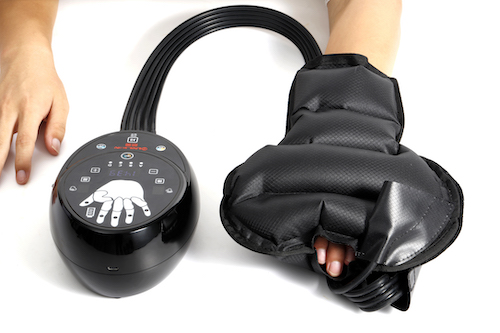
Effect of rehabilitation robot gloves combined with mirror image therapy on upper limb movement and hand function in hemiplegic patients with stroke
A study from China Health Care & Nutrition periodicals about Effect of rehabilitation robot gloves combined with mirror image therapy on upper limb movement and hand function in hemiplegic patients with stroke.
YAN Xue,ZHENG Peng,ZHANG Ya - nan,YU Miao,GAO Wan - ning,ZHANG Wei - min Changchun University of traditional Chinese medicine,Changchun,Jilin 130021 【Abstract】Objective To analyze the effect of rehabilitation robot gloves combined with mirror image therapy on upper limb movement and hand function in stroke hemiplegic patients. Methods A total of 70 patients with stroke and hemiplegia were randomly divided into an observation group and a control group. The control group was given conventional rehabilitation training. On the basis of this, the observation group added mirror therapy combined with rehabilitation robot glove - assisted treatment. After 4 weeks of treatment, the Fugl - Meyer assessment of upper extremity(FMA - UE) score,Wolf Motor Function Test( WMFT) score, and modified Barthel index of the two groups of patients were compared. Modified Barthel index (MBI)score. Results The FMA score,WMFT score and MBI score of the observation group were significantly higher than the control group(P < 0. 05),the difference was statistically significant. Conclusion Rehabilitation robot gloves combined with mirror therapy The treatment of patients with hemiplegia after stroke can significantly improve the upper limb motor function, hand function and daily life activity ability, and is worthy of wide- spread promotion and application.
After stroke patients have hemiplegia, the order of limb recovery is usually lower limbs first and then upper limbs, proximal and then distal. The motor function of upper limbs, especially the function of hands, is mainly on fine movement,and the brain control area involved is relatively large. Therefore, the recovery is relatively slow, which seriously affects the patients' daily life activities and social participation ability. Therefore, the recovery of upper limb function, especially hand function, in patients with hemiplegia is the focus and difficulty of clinical rehabilitation treatment. Mirror therapy (MT), also known as mirror visual feedback therapy. Some studies have pointed out that [4 - 5], it plays a role through the visual feedback mechanism. Using the principle of plane mirror imaging, the picture of healthy side activities is copied to the affected side, so that patients can imagine the movement of the affected side, so that the visual signal can be continuously input into the first motor area or primary motor area, so as to establish visual feedback on the affected side and have a favorable impact on the recovery of hemiplegic side. In recent years, with the deepening of the research on mirror neurons, some studies have pointed out that the possible mechanism of mirror therapy plays a role through the mirror neuron system. At present, a large number of clinical studies have pointed out that the application of mirror therapy in patients with post-stroke hemiplegia can improve the excitability of mirror neurons, and specific motor cortex areas in the brain can be activated. At the same time, a large number of repeated mirror training will form corresponding conditioned reflex [6], accelerating the formation of normal motor reflex arc, Thus, it can promote the recovery of upper limb function and hand function of stroke patients with hemiplegia, alleviate upper limb spasm and reduce the degree of neurological damage, so as to improve the ability of daily living activities and social participation of patients [7 - 8]. The action mechanism of rehabilitation robot gloves is based on the "central peripheral central" closed-loop rehabilitation intervention mode in the current theoretical system of hand functional rehabilitation, which continuously stimulates the patient's central and peripheral, so as to achieve the effect of hand functional rehabilitation. Mainly for patients with finger muscle tension increased, edema, stiffness and other symptoms of treatment. The rehabilitation robot glove combines the flexible robot technology and the theory of nerve rehabilitation. It uses the imitation pneumatic artificial muscle as the flexible power to flex and extend the patient's finger joints. At the same time, it helps the patient improve the activity ability of the hand through exercise relearning, reduce the tension of the affected hand muscle, accelerate the venous and lymphatic reflux and alleviate the edema of the finger joints, In addition, motor imagery can promote Kwai brain injury and accelerate the rehabilitation of hand function. In this study, rehabilitation robot gloves are combined with mirror therapy. While the rehabilitation robot gloves perform active and passive movement of the affected hand, combined with mirror therapy, the healthy hand makes the same action. Through visual feedback and the dual input of proprioception of the affected hand [9], the motor neurons dominating the affected hand are activated to promote the reorganization of brain function, so as to achieve the dual stimulation of the surrounding and center, So as to improve the function of patients' upper limbs, especially hands. The results of this study show that the rehabilitation robot gloves combined with mirror therapy can significantly improve the upper limb motor function, hand function and activities of daily living of patients with hemiplegia after stroke. At the same time, mirror therapy and rehabilitation robot gloves have the characteristics of simple operation, patients or family members can practice by themselves after professional guidance, and are not limited by the operation location. Therefore, this therapy can greatly reduce the rehabilitation medical expenses of patients and save medical resources. In conclusion, rehabilitation robot gloves combined with mirror therapy have positive therapeutic value for stroke patients with hemiplegia, which is worthy of clinical application。
So Xiamen Weiyou just designed and manufactured a Rehabilitation robot gloves device allow stroke patient do mirror therapy to help them recovery from limbs functional. Before do image therapy, the device with a massage glove to soften patient hand muscle, after that, do mirror therapy training.

Copyright © 2025 Xiamen Weiyou Intelligent Technology Co.,Ltd. All Rights Reserved. Power by

IPv6 network supported